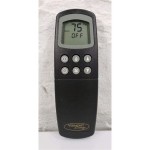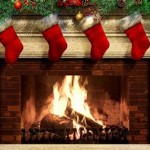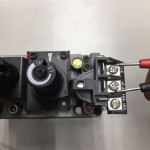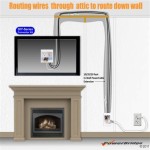Wood Mantel Shelf On Brick Fireplace: A Comprehensive Guide
The combination of a wood mantel shelf and a brick fireplace is a classic and enduring design feature in many homes. It provides a focal point for the room, adding warmth, character, and a touch of rustic elegance. However, understanding the nuances of installation, design considerations, and safety precautions is crucial for achieving a visually appealing and functionally sound result. This article will explore key aspects of integrating a wood mantel shelf onto a brick fireplace, covering selection criteria, mounting techniques, and relevant building codes.
The initial decision involves selecting the appropriate wood for the mantel. Hardwoods like oak, maple, walnut, and cherry are popular choices due to their durability and aesthetic appeal. Softwoods, such as pine or fir, can be more cost-effective but may require more care to prevent scratches or dents. The choice depends on the desired aesthetic, budget, and the overall style of the room. Consider the existing woodwork in the space to ensure the mantel complements the surrounding decor. The wood should be properly seasoned and treated to prevent warping, cracking, or insect infestation.
Beyond the type of wood, the dimensions of the mantel shelf are critical. The length should be proportional to the width of the fireplace, typically extending several inches beyond the firebox opening on each side. The depth of the shelf should be sufficient to accommodate decorative items without appearing bulky or obstructive. The height above the firebox is also a crucial safety consideration. Building codes often specify minimum distances to combustible materials to prevent fire hazards. Consulting local fire codes or a qualified professional is essential before installation.
Selecting the Right Mounting Method
Mounting a wood mantel shelf onto a brick fireplace requires careful consideration of the brick’s structural integrity and the weight of the mantel. Several methods can be employed, each with its own advantages and disadvantages. One common approach involves using heavy-duty concrete screws or anchors that are specifically designed for masonry. These anchors are inserted into pre-drilled holes in the brick and provide a secure hold. The drill bit size must be precisely matched to the anchor size to ensure a tight fit. Over-drilling can compromise the holding power of the anchor, while under-drilling can make installation difficult or damage the brick.
Another method involves using a steel support bracket that is anchored to the brick wall. The mantel shelf is then attached to the bracket. This method is particularly suitable for heavier mantels, as the bracket distributes the weight more evenly and provides greater stability. The bracket should be made of heavy-gauge steel and be appropriately sized for the mantel's dimensions. The placement of the bracket is crucial to ensure that the mantel is level and secure.
Mortar joints can also be utilized for mounting, though this method requires more skill and precision. Mortar is removed from the joints, and metal supports are inserted into the resulting cavities. The mantel shelf is then placed onto these supports, and the mortar is replaced to secure the shelf in place. This method can be aesthetically appealing as it minimizes visible hardware, but it is essential to ensure that the mortar is properly mixed and applied to achieve a strong bond.
Addressing Safety Considerations
Fire safety is the paramount concern when installing a wood mantel shelf above a fireplace. As previously mentioned, building codes specify minimum clearances between combustible materials and the firebox opening. These clearances are designed to prevent the mantel from catching fire or smoldering due to excessive heat exposure. The type of fireplace, whether it is a wood-burning, gas, or electric model, will influence the required clearances. Wood-burning fireplaces typically require greater clearances than gas or electric models due to the higher temperatures they generate.
If the required clearances cannot be met, heat shields can be installed to protect the mantel from excessive heat. These shields are typically made of metal and are designed to deflect heat away from the combustible material. The heat shield should be properly sized and installed according to the manufacturer's instructions. Regular inspection of the mantel and heat shield is recommended to ensure that they are functioning correctly and that there are no signs of charring or damage.
In addition to fire safety, structural safety is also important. The mantel shelf must be able to support its own weight and the weight of any decorative items placed on it. Overloading the mantel can cause it to sag or even collapse, posing a safety hazard. The chosen mounting method must be adequate to support the anticipated load. Regular inspection of the mounting hardware is recommended to ensure that it remains secure and that there are no signs of loosening or corrosion.
Design and Aesthetic Integration
Beyond the technical aspects of installation, the design and aesthetic integration of the wood mantel shelf are crucial to achieving a visually appealing result. The style of the mantel should complement the overall style of the room. A rustic mantel with rough-hewn edges might be appropriate for a country-style home, while a sleek and modern mantel with clean lines might be better suited for a contemporary space. Consider the existing colors and textures in the room when selecting the finish for the mantel. A stained mantel can highlight the natural grain of the wood, while a painted mantel can provide a pop of color or blend seamlessly with the surrounding walls.
The size and shape of the mantel should be proportional to the fireplace and the surrounding wall. A mantel that is too large can overwhelm the space, while a mantel that is too small can appear insignificant. The shape of the mantel can also influence the overall aesthetic. A simple rectangular mantel can provide a clean and modern look, while a more ornate mantel with carvings or moldings can add a touch of traditional elegance.
Finally, consider the decorative items that will be placed on the mantel. These items should be carefully chosen to complement the mantel and the overall style of the room. Overcrowding the mantel can create a cluttered and unappealing look. Instead, opt for a few carefully selected pieces that add interest and personality to the space. Incorporating elements of varying heights and textures can add visual depth and dimension to the mantel display.

How To Install A Mantel On Brick Fireplace 1905 Farmhouse

Diy Rustic Fireplace Mantel The Cure For A Boring

How To Install A Floating Mantle The Easy Way In Just One Afternoon

How To Install A Mantel On Brick Fireplace 1905 Farmhouse

30 Timeless Wood Mantels For Brick Fireplace Designs

Easy Fireplace Mantel Diy

Attach Wood Mantel On White Brick Fireplace Block Mantle Painted Fireplaces

30 Timeless Wood Mantels For Brick Fireplace Designs

Rough Hewn Wood Diy Fireplace Mantel Addicted 2 Decorating

How To Install Decorate Wood Fireplace Mantels
Related Posts








